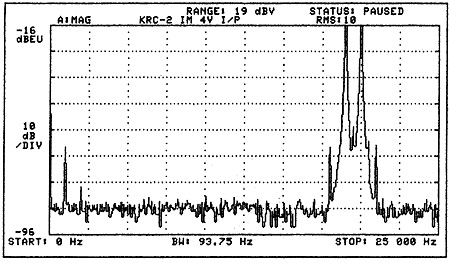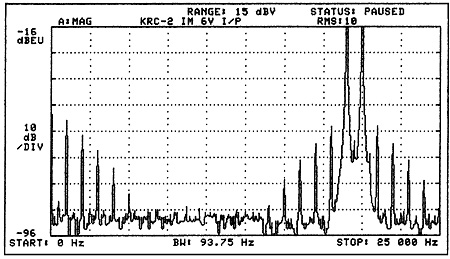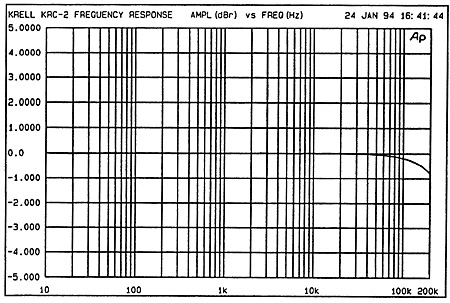Krell KRC-2 preamp
Listed · 638 Views
This listing has ended.
Listings Similar to Krell
Time Left: Listing Sold
This listing has ended.
| Condition | |
| Payment methods | |
| Ships from | Los Angeles, CA, 90077 |
| Ships to | United States and Canada |
| Package dimensions | unspecified |
| Shipping carrier | USPS |
| Shipping cost | |
| Original accessories | Manual |
| Research Pricing |
Beautiful Krell KRC-2 preamplifier.
Value is what you will find in this Krell KRC-2 preamp.
Good sound at a reasonable price, The KRC-2 had very good reviews in its time.
This unit is in excellent condition, looking almost like brand new.
The sound is expansive and full, offering a nice soundstage and good detail.
This unit comes with the original owners manual, but we don't have the remote or the factory box, but that will translate to lower pricing on this already great value preamp.
Stereophile magazine gave the KRC-2 a great review:
Krell KRC-2 line preamplifier
Martin Colloms | Oct 28, 2007 | First Published: Jun 28, 1994 There's always a certain amount of jockeying for position at the very top of the High End. Every few months, a new star burns brightly, getting all the attention. While the constant turnover at the cutting edge helps to define the state of the art, audiophiles should keep their eyes on the longer term. It's a company's track record—examined over a period of years—which defines its position in the market and the credibility of its products.
image: https://www.stereophile.com/images/archivesart/94krellkrc2.jpg

Ever since I made the acquaintance of my first Krell product—the KSA-50 power amplifier—I've been impressed by this Connecticut-based company's offerings. Krell has managed to maintain its position at or near the leading edge of sound quality since the company was started by Dan and Rondi D'Agostino at the beginning of the 1980s. When it comes to design and build quality, Krell products are first-rate. This month or this year, a Krell product may not always be the very best-sounding in its class, but the chances are that it will come close. What also matters is enduring character and quality—this is where superb build, a durable finish, and a conservative design philosophy pay off.
This review looks at a model from Krell's relatively new amplification range: the KRC-2 preamplifier.
Krell KRC-2 :
The undoubted convenience of remote volume control adds much to the appeal of audiophile preamplifiers. Krell has supplemented their $6500 two-box remote-control KRC control unit (footnote 1) with the $3700, one-box Krell KRC-2. The KRC-2 offers a similar mix of balanced and unbalanced facilities, and can be regarded as a remote-controlled successor to Krell's successful KSL preamplifier of a few years back (footnote 2).
The versatile handset offers almost complete system control, with buttons for CD player/transport—track step, back track, advance, play, pause, and stop—and power-amplifier functions, as well as the normal preamplifier buttons. Krell's "S"-series power amplifiers can be powered up from standby with the handset, which also has a display "muting" button specifically for these power amplifiers (this is a great convenience). Volume heads the list of remote-control preamplifier functions, followed by channel balance (1dB steps), output mute, normal or inverted absolute polarity, input source selection, tape monitor, and switched line gain. Reflecting the universal nature of modern audio, the remote interfacing is compatible with future multi-room and/or audio/visual switching systems.
The KRC-2, described by Krell as being fully balanced internally, is one of very few such units at this price level. All input and output terminals are gold-plated; the phono sockets are high-grade solid machined types with a PTFE dielectric. The KRC-2's single-ended inputs are labeled S-1 to S-4, with one nominated for the auxiliary analog disc input. B-1 and B-2 are the two balanced inputs. For the tape monitor, an additional "S" input may be used as an auxiliary input if no tape system is in use. (The tape output is buffered to prevent interaction with the main signal path.) The remote preamp controls are replicated in pushbuttons on the KRC-2's handsome, brushed-alloy fascia.
The only rotary control is for volume; buttons cover control of balance in association with two vertical strips of LEDs which indicate the balance setting. The volume control is a smooth, continuously rotating encoder; there are no end stops. This can be initially confusing, but you soon get used to it. A 270° arc of 15 red LEDs indicates signal level, the length of the illuminated arc corresponding to a conventional volume scale. More to the point, the electronics at work behind this control deliver noiseless, nicely graduated volume steps.
KRC-2 has no mains power switch. Like many remote-controlled preamps of moderate power consumption, it is left permanently in standby, ready to be energized or otherwise at the touch of a button. The detachable 3-pin cord is grounded, the preamp providing a quiet ground reference for the system.
Technical Details :
Krell's circuitry is all discrete, comprising DC-coupled complementary amplifiers with a complementary differential-FET input stage and a powerful class-A output stage. Heavy-duty power supplies with cascaded regulators are the norm.
Whereas the more expensive KRC uses a motor-driven Penny & Giles potentiometer to control level, the KRC-2's volume control ostensibly uses an R/2R ladder with individual resistors selected by solid-state switches, in this case FETs in full conduction mode. These FET switches are contained in standard IC DIP arrays. This topology has allowed Krell to realize the volume control in a fully balanced form. There are thus four sections: left "hot" and "cold," and right "hot" and "cold."
Manually rotating the volume knob operates an optical encoder, both its and the handset's control signals being fed to a digital register. The output codes switch the FETs on and off, giving level resolution equivalent to that of a 14-bit analog multiplier. This gives the potential of controlling gain in 160 steps. Krell has chosen a "law" which approximates well to the nearly logarithmic characteristic of the human ear. At high settings of the volume control, the steps are finely graded at 0.3dB. At –—0dB, the step resolution falls a little to 0.5dB, with 1dB steps between –40dB and –50dB. From –50dB to –60dB, the steps are still respectable at 1.5dB; the output is muted one notch below –60dB.
Conventional preamplifiers feed line-level input signals direct to a volume potentiometer with a more or less infinite dynamic range. The FET switches used in the KRC-2 volume control have a finite dynamic range, however. Though this could result in mild distortion at high input levels, this will generally be benign since it will be of low harmonic order. Nevertheless, with high-level inputs (over 3V), it could be an area to watch.
All other switching is done by means of selected electro-mechanical relays, their chosen state stored electronically. Using relays allows the switches to be placed ideally at the input position, which can improve circuit-board tracking and beneficially shorten signal paths.
Listening :
Fresh out of the box, the KRC-2 gave a promising account of itself. Like Krell's Reference 64 D/A processor, however, this preamplifier requires a significant break-in period—its full abilities became apparent only after several days of use.
Before this happened, first impressions were of a substantially positive sound, but suggested that this unit was not all that far removed from the older, less-expensive Krell KSL. As the KRC-2 "ran in," however, the gap between it and the KSL widened, with the new design establishing superior levels of midrange neutrality, treble purity, and bass definition. The KRC-2's greater sonic transparency led to enhanced image depth, with stage width increased in like proportion. In fact, if reasonable care was taken—not overdriving the inputs, for example—then the performance of the KRC-2 closely approached that of its big brother, the KRC. The latter had slightly better midrange dynamics and low-frequency grunt, but the difference between the two preamps was not great.
The KRC-2 was so neutral and well-balanced overall that my listening notes were not extensive, there being little untoward for a listener to latch onto. The KRC-2 was very compatible with the KSA-200S or KSA-100S amplifiers, in all areas: absolute merit, transparency, tonal neutrality, and extension and control of the frequency extremes. Remote control of absolute polarity proved to be a boon. Time and time again, corrections for unknown recording practices gave a slightly richer, fuller sound, with improved soundstage perspective.
As I found in my HFN/RR review of the KRC (footnote 3), the KRC-2 sounded both more "open" and musical set to its higher gain (hence lower feedback) setting. (This is also true of some other high-performance preamplifiers; for example, the Audio Research LS-5.) Thanks to the Krell's well-designed volume-control law, this is no disadvantage.
Conclusions :
Considered as a complete moving-coil–equipped preamplifier, the KRC-2/KPE combination is quite expensive at $4595. At this price, high standards are expected; by and large, the KRC-2 meets them, even closely approaching the performance of its bigger brother, the KRC.
I liked the convenience of remote-control operation; after initial misgivings, I found the volume control's action and range to be effective. I also liked the remote polarity-invert switch, and found myself using it more often than expected. I also liked the KRC-2 for its ability to handle signal sources and amplifier loads in balanced or unbalanced formats—this greatly aided the review comparisons. Given that the KRC-2 is fully balanced internally, it was nice to hear that it gave a very similar performance in either mode. (I feel strongly that if balanced design is promoted as a virtue, then the relevant equipment should still be fully effective in an unbalanced environment, if so required.)
Where the KRC-2 falls down—but oh, so gently—is in the matter of its line-input overload margin. At a nominal CD-player output level of 2V, the KRC-2 reaches a threshold, with increased limiting and low harmonic-order distortion becoming apparent above this level. To get the very best from a KRC-2, therefore, do not go above a 5V input signal level (±5V balanced). A simple line attenuator can be used for sources offering higher maximum signal levels (footnote 4).
This caution aside, I found the KRC-2 to be a well-balanced performer: neutral, reliable, satisfying, and capable of inspiring confidence. Musically, it approaches the Class A performance of the KRC; it can therefore be included in that handful of state-of-the-art preamplifiers costing between $5000 and $10,000. And, as one of the least expensive designs in this group, it is an easy recommendation. Don't expect the KRC-2 to grab you by the throat; rather, settle back and let its soundly balanced performance convince you that sonic fireworks are unnecessary for long-term owner satisfaction.
Footnote 1: Thomas J. Norton reviewed the $6900 KRC preamplifier in January '94 (Vol.17 No.1, p.92), and the KRC's $500 internal phono stage in March '94 (Vol.17 No.3, p.114).—John Atkinson
Footnote 2: The still-current Krell KSL was reviewed in July 1991, Vol.14 No.7, p.96.—John Atkinson
Footnote 3: Vol.37 No.11, November 1992, p.43.—John Atkinson
Footnote 4: Use Vishay VSRJ resistors or the equivalent. For a 4V source, for example, try a couple of 47k resistors in each of the channel's signal legs. Use one resistor in series and one in parallel with the KRC-2 input. The attenuation is close to a factor of three, or –10dB, while keeping the loadings in good order.—Martin Colloms
Krell KRC-2 line preamplifier Specifications
Sidebar 1: Specifications
Description:
Solid-state line-level preamplifier.
Frequency response: 0.2Hz–400kHz +0, –—dB.
Distortion: lower than 0.002%, –94dB, 20Hz–20kHz.
S/N ratio: 95dB.
Input impedance: not specified.
Output impedance: not specified.
Maximum output level: not specified.
Voltage gain: not specified.
Dimensions: 19" W by 2.5" H by 14.5" D.
Warranty: 5 years parts and labor, limited transferable.
Approximate number of dealers: 55.
Manufacturer: Krell Industries, 45 Connair Drive, Orange, CT 06477. Tel: (203) 799-9954. Fax: (203) 799-9796. Web: www.krellonline.com.
Krell KRC-2 line preamplifier System
Sidebar 3: Measurements
The KRC-2's measured line-input input impedance was 50k ohms unbalanced, 100k ohms balanced. Though this is higher than earlier generations of Krell preamplifiers, it will reduce the loading on source components. The measured voltage gain was nearly twofold (5.45dB), increasing to fourfold (11.28dB) with the "gain" switch engaged. Over the 60dB operating range of the volume control, the channel balance was found to be generally better than 0.05dB. This is an excellent tolerance, defined by the use of precision discrete-resistor arrays. Balanced and unbalanced outputs matched to within 0.01dB (0.1%), promising good common-mode rejection ratios.
The line-input signal/noise ratio, both weighted and unweighted, was typically 100dB when referred to the standard IHF 500mV input level. Referred to a more typical 2V input, this Krell preamplifier's noise is a true 110dB or so down. Tight +0.015dB/–0.05dB limits sufficed for a wide and flat 15Hz–25kHz frequency response. With the specified +0, –3dB limits, the response ranged from near-DC, 0.2Hz, to greater than 300kHz. No RF or other additional ultrasonic filtering is present. However, the KRC-2 did not show any susceptibility to RF.
Interestingly, channel separation for the line inputs was poor. Separation was around 75dB in the midrange, dwindling to just 49dB at 20kHz. This figure was very sensitive to the source impedance used to drive the "silent" channel. Reducing the source impedance from 600 to 100 ohms on this channel improved the separation by 11dB.
Krell quotes better than 0.002% THD, –94dB, from 20Hz to 20kHz, but they do not specify the loading, input level, or output level used to reach this figure. With careful checking, I could reach no better than –84dB at 1kHz and –78dB at 20kHz.
A "soft" overload characteristic could be seen, with a gradual increase in distortion components observed for input levels over 2V. At 1V (unbalanced), the distortion was –80dB (0.01%) at low and mid frequencies. At 20kHz, the distortion increased to –73dB. Doubling the input level resulted in these figures all worsening by 10dB, while at 5V input (20dB above the nominal IHF 500mV level), the midband distortion was now –60dB, or 0.1%. The distortion hit –46dB (0.5%) at an input level of 6V RMS. While this level is high, it is not impossible with some D/A processors and pro gear.
I further explored the distortion performance of the line input using a 19–20kHz mixed tone. While the intermodulation was negligible with a 2V input level, at 4V the 1kHz component was beginning to kick up (fig.1); and at 6V, the whole harmonic IM series can be seen to be developing (fig.2). Fortunately, at moderate input levels this mild distortion was of low harmonic order, and therefore relatively benign, subjectively.
image: https://www.stereophile.com/images/archivesart/94KRC2fig1.jpg

Fig.1 Krell KRC-2, HF intermodulation spectrum, DC–25kHz, 19+20kHz at 4V input level (linear frequency scale, 10dB/vertical div.).
image: https://www.stereophile.com/images/archivesart/94KRC2fig2.jpg

Fig.2 Krell KRC-2, HF intermodulation spectrum, DC–25kHz, 19+20kHz at 6V input level (linear frequency scale, 10dB/vertical div.).
The KRC-2's maximum output level was 8V RMS (16V balanced), sufficient for any domestic application. Even when driven to its full 8V output level, the preamp's output was not affected by a tough 300 ohm load. The output impedance was a very low 12.2 ohms; the preamplifier is, in fact, powerful enough to drive a pair of sensitive moving-coil headphones to sensible sound levels. DC offset levels were below 1mV.—Martin Colloms
image: https://www.stereophile.com/images/archivesart/94KRC2fig3.jpg

Fig.3 Krell KRC-2, line-stage frequency response (solid)(1dB/vertical div.). Stereophile June 1994, Vol.17 No.6
It is best to call David and visit: www.weinhartdesign.com with questions in Los Angeles Showroom 310-472-8880 or on my cell after hours and weekends 310-927-2260 any time from 10AM - 10PM.
Weinhart Design has lots of other items new and used and if you're in Los Angeles or visiting please accept my invitation to experience our World Class Audio Showroom and please visit our web site @ www.weinhartdesign.com
We are always interested in purchasing quality Audio and Video items, LP collections and most quality trades are welcomed.
All sales out of California are California State Sales Tax exempt.
California State Sales Tax of 9.5% applies for items picked up or shipped to a California address.
We accept payments by Bank Wire Transfers without fees and is the only form of payment on all sales out of the U.S. and Canada. We prefer this method of payment and also makes shipping to addresses other than billing agreeable.
VISA, MC and Papal are gladly accepted within the U.S. and Canada as long as the charge is approved and shipping to
the billing address on record and adds 3% to cover costs.
Please call me directly in my world class showroom in Los Angeles weekdays @ 310-472-8880 or any reasonable time on my cell including weekends @ 310-927-2260 and I can answer your questions and help you with all of your new and pre owned needs.
Changing the Way You Listen,
David Weinhart
Weinhart Design, Inc.
President & CEO
[email protected]
www.weinhartdesign.com
The Audio and Video Expert
2337 Roscomare Road, Studio #1
Los Angeles, California 90077
Showroom) 310-472-8880
Cell) 310-927-2260
No questions have been asked about this item.
Ask the seller a public question
You must log in to ask a question.
Return Policy
Return Window
Returns are not accepted on this item.


